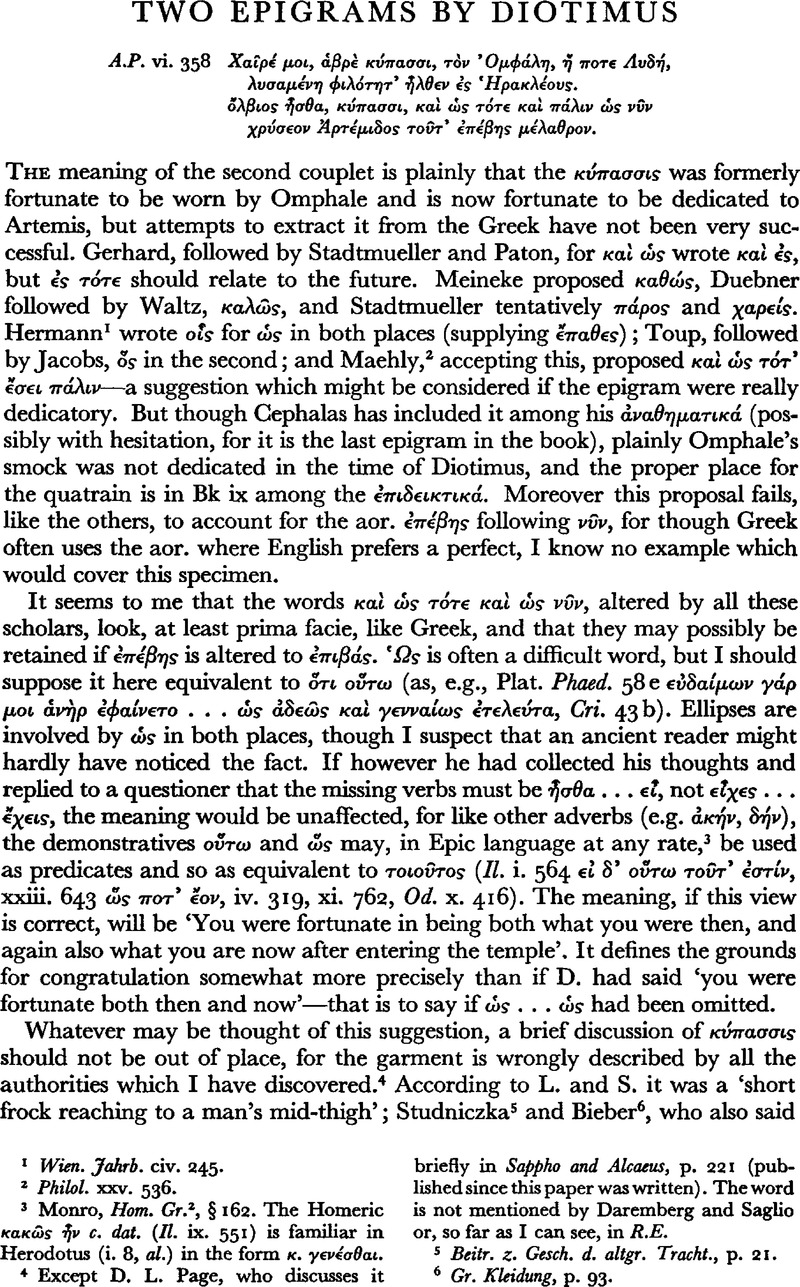No CrossRef data available.
Article contents
Two epigrams by Diotimus
Published online by Cambridge University Press: 13 February 2009
Abstract

- Type
- Review Article
- Information
- Copyright
- Copyright © The Classical Association 1955
References
page 238 note 1 Wien. Jahrb. civ. 245.
page 238 note 2 Philol. xxv. 536.
page 238 note 3 Monro, Hom. Gr. 2, §162. The Homeric κακ⋯ς ἦν c. dot. (Il. ix. 551) is familiar in Herodotus (i. 8, al.) in the form κ.γεν⋯σθαι
page 238 note 4 Except D. L. Page, who discusses it briefly in Sappho and Alcaeus, p. 221 (published since this paper was written). The word is not mentioned by Daremberg and Saglio or, so far as I can see, in R.E.
page 238 note 5 Beitr. z. Gesch. d. altgr. Tracht., p. 21.
page 238 note 6 Gr. Kleidung, p. 93.
page 239 note 1 Smith's Dict. Ant. ii. 944.
page 239 note 2 Hence Meineke's conjecture that Ion was describing Heracles in Omphale's clothes is insecurely based.
page 239 note 3 It is always so called by lexicographers, and Lycophron (333 as emended), to improve on Il. iii. 57 λ⋯ινον ἕσσο χιτ⋯να, substitutes κύπασσις for that word.
page 239 note 4 I leave to some maior Apollo the interpretation of Or. Sib. 5. 186, ![]() , and should hardly venture to infer that the κ. was Cyrenaic wear; nor from the fact that Harpocration cites the word from Aristophanes and Lysias that it was Attic.
, and should hardly venture to infer that the κ. was Cyrenaic wear; nor from the fact that Harpocration cites the word from Aristophanes and Lysias that it was Attic.
page 239 note 5 I do not see what inference, if any, can be drawn from the fact that in Alc. fr. 15. 6 κυπ⋯σσιδες appear in a list of warlike gear.
page 239 note 6 See J.H.S. xlviii. 143.
page 240 note 1 Philol. xxv. 537.
page 240 note 2 Comment. Crit. i. 296.
page 240 note 3 Sozom. Hist. Eccl. vii. 26, and later Hierocl. Gramm. 651.
page 240 note 4 Waltz said that if the author of the epigram was D. of Adramyttium, as Stadtmueller and Wilamowitz supposed, ‘il ne serait pas étonnant que des Égyptiens eussent des relations avec la Cyrénaïque’—from which it would appear that he located Adramyttium in Egypt.
I will not here discuss whether in addition to Diotimus of Miletus (A.P. v. 106) a poet of the second Garland, the first, Meleager's, contained the works of one Diotimus, or, as is now generally held, of two. Apart from D. of Miletus only one of the eleven epigrams headed Διοτ⋯μου characterizes the author, and that is vii. 420, where the corrector of the Palatinus has written in an erasure Δ. Ἀθηνα⋯ου το⋯ Διοπε⋯θους. Reitzenstein (R.E.5. 1149) said that this was information derived from a second copy of the Anthology, ‘da ein Grund diesen Zusatz zu erfinden nicht nachweisbar ist’. The son of Diopeithes, was, I should have thought, a figure of sufficient celebrity in fourth-century Athens (see R.E. 5. 1148) to explain a guess, in the same sort of way that epigrams headed Ἀλκα⋯ου Μυτιληνα⋯ον are, in at any rate some cases, by the less famous A. of Messene (see A.P. vi. 218, vii. 5, 55. 429, 536). The son of Diopeithes was dead by 325 B.C., and some of the epigrams are evidently too late to have been written in the fourth century and too early to be by D. of Miletus. Therefore, if the ascription to the Athenian is accepted, a third Diotimus must be assumed. He is, rightly or wrongly, supposed to be the D. of Adramyttium on whom Aratus wrote a couplet (Steph. Byz. s.v. Γ⋯ργαρα, A.P. xi. 437), but I see no means of solving the problems presented by these ascriptions.
page 240 note 5 I ought to have suggested (elsewhere) that when Theocritus wrote ἔβα ῥ⋯ον, Il. xxiii. 71 ![]() may have been in his mind, though his readers will hardly have thought of the lines.
may have been in his mind, though his readers will hardly have thought of the lines.




